8/11/2021:
Over the past decades, broilers have been growing at an increasing rate. This is not only due to changes in their genetic composition but also through improvement of housing, nutrition and management. The increase in the breast meat weight of broilers is particularly striking. As the slaughter weight of broilers increases, in combination with the growth curve required to achieve this slaughter weight, we are seeing a number of muscle abnormalities which influence the quality. We shall discuss the main ones here. None of these muscle abnormalities are clearly visible in the living chicken, and therefore often only become apparent during the slaughter process.
Deep pectoral myopathy
Deep pectoral myopathy (DPM) is also known as green muscle disease. This is not a form of contagious disease, but rather a wasting of the deep pectoral muscle due to blood supply issues.
How does it occur?
The deep pectoral muscle is located between the breastbone and the breast meat (the superficial pectoral muscle) and is used when chickens move their wings. Broilers are extremely muscular and this muscle therefore has little space for expansion. If the broiler flaps its wings energetically, there is extra blood supply to this muscle. This is the body’s way of ensuring that the muscle has sufficient oxygen supply and sufficient disposal of waste products. All that extra blood results in the muscle becoming temporarily expanded. When the muscle contracts, it is smaller than when in a relaxed state. If the muscle then swells excessively in this state due to the extra blood, the situation can arise whereby the muscle no longer has enough space to relax normally. The pressure will then increase to such an extent that the blood vessels around the muscle are compressed, stopping the blood from flowing out of the muscle. No new blood can be pumped in, resulting in myopathy of the muscle tissue due to a lack of oxygen and the accumulation of waste products. This may colour the muscle tissue green, hence the name green muscle disease.
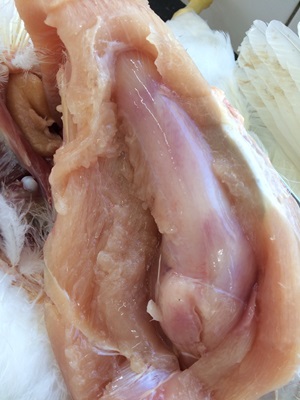
Photo 1. Early phase of green muscle disease (Source: GD)
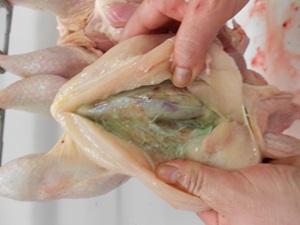
Photo 2. Green muscle disease (Source: NVWA)
White striping and Wooden breast
White striping (WS) is characterised by white stripes running parallel to the muscle fibres of the breast meat (the large pectoral muscle/pectoralis major). These stripes can vary in thickness and give the meat a marbled appearance. Wooden breast (WB) is characterised by a pale and extremely sturdy breast, which can sometimes be as hard as wood (hence the name wooden breast). WB and WS are two possible manifestations of the same underlying problem and are therefore discussed together here.
How does it occur?
While the exact cause is unknown, the abnormality seems to be the result of a localised oxygen deficiency. Unlike deep pectoral myopathy however, there is no complete blockage of the oxygen supply in WS and WB. It seems more likely that there is a long-term slight shortage of oxygen and ineffective discharge of waste products. This is probably due to the growth of the system of blood vessels being incapable of keeping pace with the rapid growth of the muscle tissue. This rapid growth of muscle tissue primarily takes place in the frontal (thick) side of the broiler breast. If there is a slightly insufficient blood supply over a longer period of time, muscle tissue will waste away. It is replaced by connective tissue. This connective tissue is much harder than muscle fibre and has poorer blood circulation. Consequently, as more and more muscle fibre is replaced, the muscle becomes increasingly hard and pale. A period of rapid growth is a risk factor, and WS and WB are both found in standard farmed broilers and in slower growing broilers. The abnormality is not stress-related, nor is there any contagious disease involved.
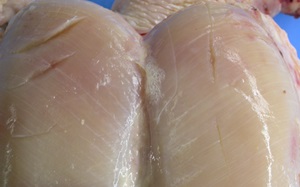
Photo 3. White striping

Photo 4. Wooden breast
Spaghetti meat
In the case of spaghetti meat (SM), the outer layers of the breast fillet fall apart into wet, loose strips when mechanically processed. This disorder gets its name from the fact that these strips somewhat resemble spaghetti.
How does it occur?
SM is the result of a poor connection between the bundles of muscle fibre as a result of underdeveloped connective tissue within the muscle. This is not a contagious disease. SM is not apparent during the life of the broilers and is a typical abattoir discovery; it is regarded to be a quality problem for the meat rather than a health problem in the broiler.
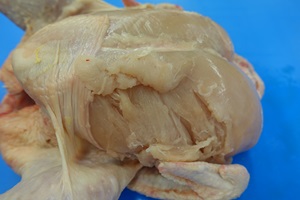
Photo 5. Spaghetti meat
Dorsal cranial myopathy
In dorsal cranial myopathy, there is continuous wasting of muscle tissue in the back muscle (anterior latissimus dorsi; ALD). This is a well-known abnormality in broilers, first detected in 2002. Up to 6 percent of the animals may have the abnormality in an affected flock (percentage based on 2009 research). This high prevalence is seen in combination with wooden breast and with heavier slaughter-weight broilers.
How does it occur?
There is one main difference between this disorder and the muscle disorders described above, namely the type of muscle fibre. The ALD comprises slowly contracting muscle fibres (the so-called slow twitch muscle fibres), unlike the pectoral muscle (in WB and WS) which contains quickly contracting muscle fibres (fast twitch muscle fibres). Slow twitch fibres have a much higher volume of blood vessels, due to these muscle fibres having an oxygen-rich energy uptake, while the fast twitch muscle fibres require less oxygen for their energy uptake. Although the blood supply is therefore generally more effective, the muscle is much less capable of coping with an oxygen deficiency. Animals suffering from dorsal cranial myopathy probably have an issue with the blood flow to this muscle, resulting in a decreased supply of oxygen. In some cases, this muscle is possibly sometimes pinched by the strongly developed muscles of the broilers. The disorder is particularly seen in extremely muscular broilers. Once again, this is not a contagious disease.
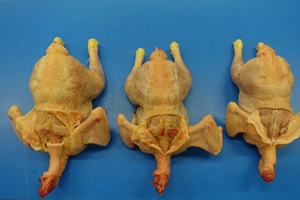
Photo 6. The skin of these carcasses has been opened: dorsal cranial myopathy can be seen in the underlying muscles of the left-hand and middle carcass; the right-hand carcass shows no abnormalities. (Source: GD)
Identification of muscle disorders in animal health monitoring
Broilers suffering from the disorders described here will appear healthy in the house and will not demonstrate any abnormal behaviour. They will not show any signs of pain. There is therefore no reason to submit these animals to GD for pathological examination. These disorders often only become visible at the abattoir. Abattoir staff can submit carcasses to GD, and the staff at NVWA (the Netherlands Food and Consumer Product Safety Authority) also submit carcasses, due to a new or striking pathology, for example, or a drastic change in prevalence. Animal health monitoring therefore has no insight into the prevalence of the disorders, though we do keep a close eye on any sudden new pathologies or drastic changes.
Our expert Robert Jan Molenaar